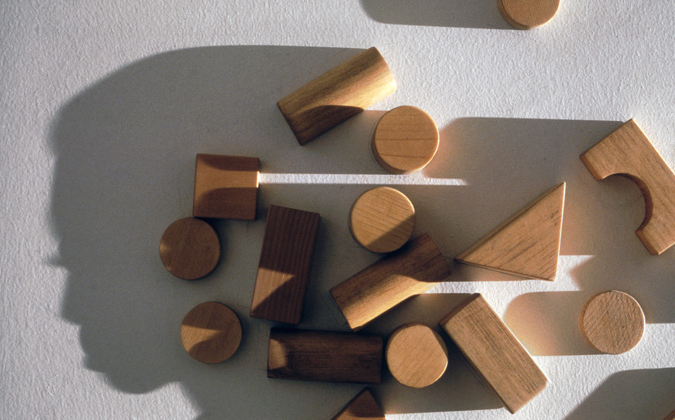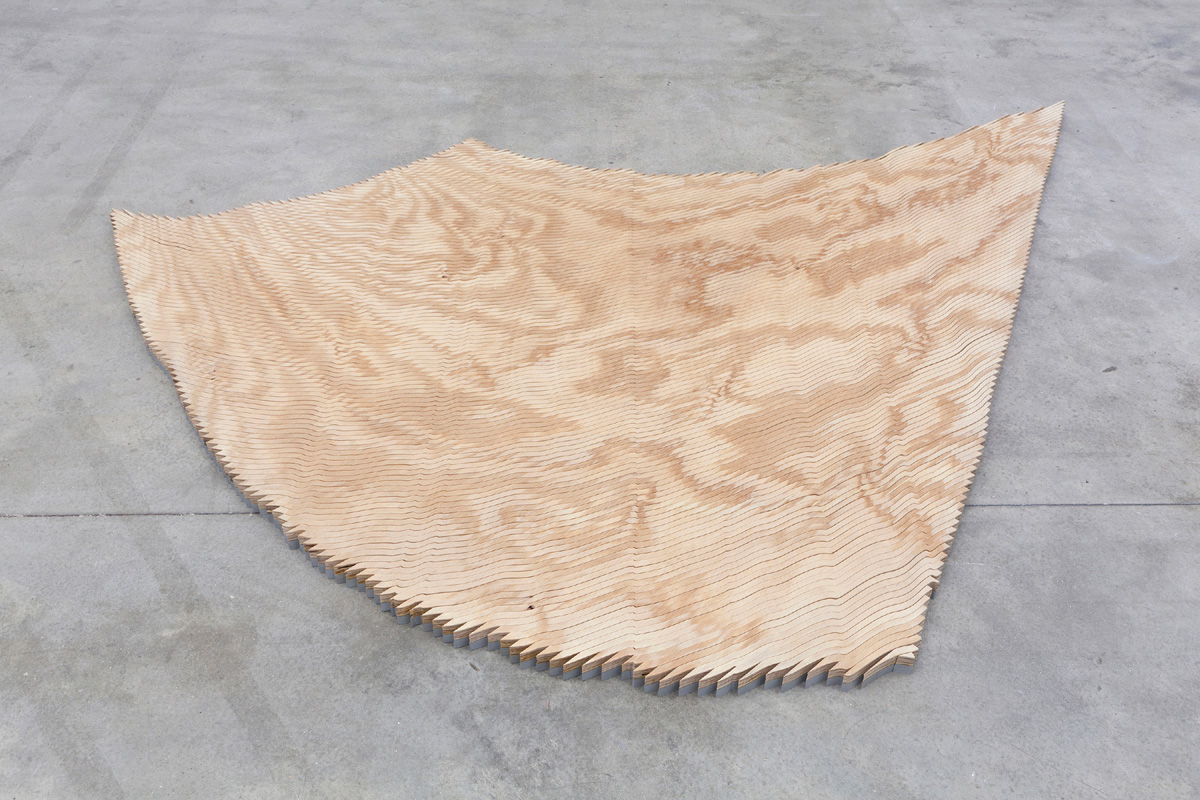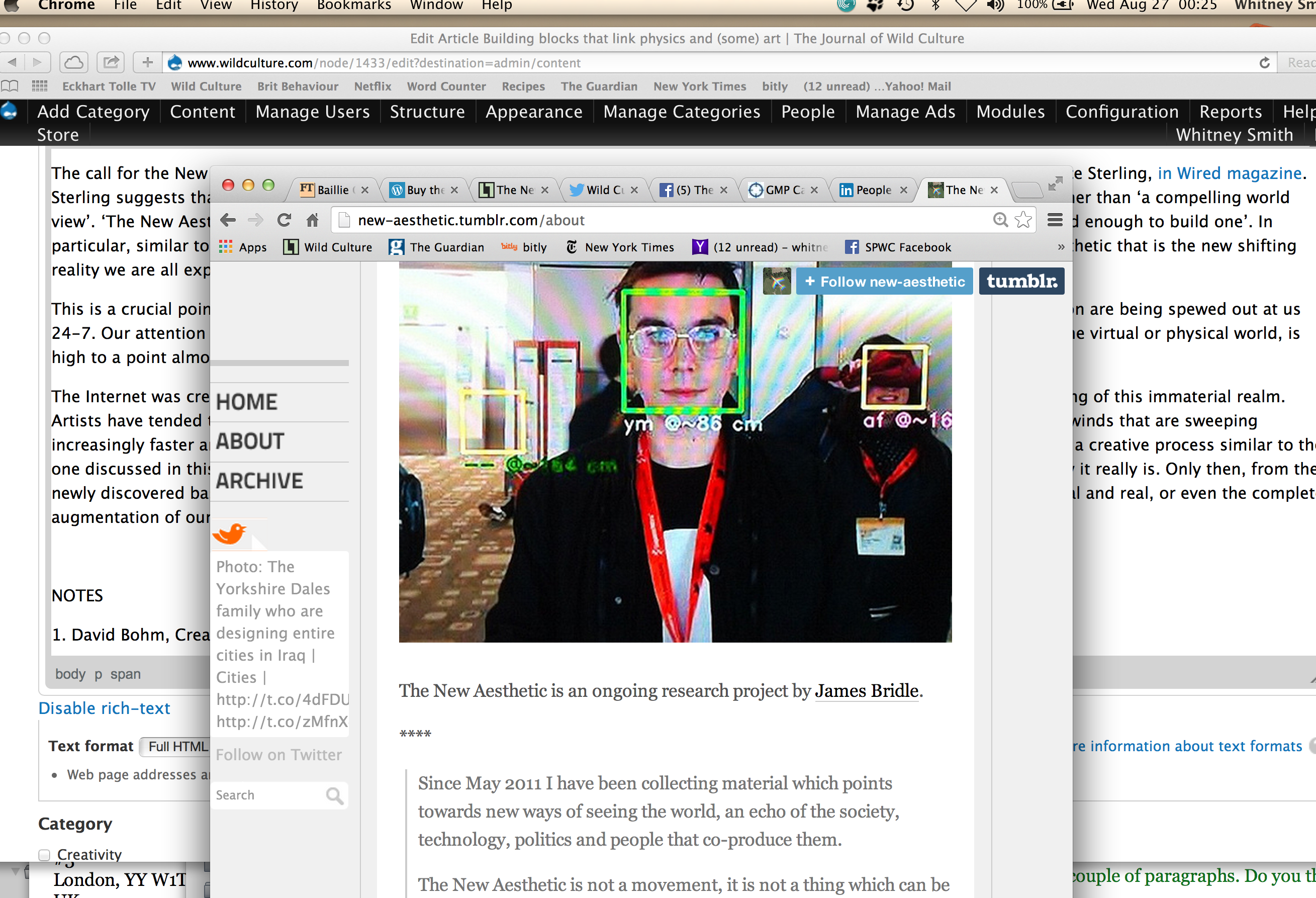
Blackboard from quantum physics lab.
I had always been torn between the arts and sciences. Coming out of school at the age of 18, it seemed like the obvious thing to accept my place on a physics degree at Imperial College in London. “You’ll make more money,” people said, or “What job will you get if you follow art?” The urge to make art never really went away, though becoming an active researcher in the field of quantum physics did partially satisfy my creative side. I remember spending all day in the university physics department, fitting pieces of my current puzzle together, then dashing home in the evening to work on an art project into the wee hours.
Science was concerned not only with practical problems, but also with psychological needs . . .’
As I progressed with my science career it was clear that it was suffering from my split focus. One sort of answer came in the form of a new course at Central St. Martins College of Art, MA Art and Science, which seemed like the kind of program that could integrate my two passions. After a year on the course, I am still intrigued about how these two fields can combine, and with luck, fill my needs. To many people the two fields may appear to completely diverge and stand in opposition to each other. For that reason I’d like to explain my thoughts so far about this dual focus.

Due to the prevailing scientific view of the universe, in recent times art and science have tended to remain separate. It was Kant who suggested that a human mind could neither confirm, deny, nor scientifically demonstrate the ultimate nature of reality. Since then, reality has been increasingly understood as something external to us — to be examined via physics rather than meta-physics. Quantum physicist David Bohm said science ‘was concerned not only with practical problems of assimilating nature to man’s physical needs, but also with the psychological need to understand the universe.’1 Science has been developed as our honest partner. In other words, it delivers an objective, operational view of the world, in which abstracted theories are tested by rigorous experiments — and sit outside our personal experience.
Art, on the other hand, continues Bohm, has ‘helped man to assimilate the immediately perceptual aspects of experience into a total structure of harmony and beauty.’ Art is a highly subjective and poetic area of knowledge, which also makes the task of coming up with a definition of beauty, and what now constitutes art, notoriously difficult! And, unlike scientists, artists work with concrete objects made from physical materials that can be observed without instruments. (Indeed, it can be argued that conceptual art removed the need for physical art objects altogether. For the purposes of this discussion, I’ll lay that to the side for now.
These contrasts between art and science make for a challenging discussion of the two, yet, while retaining the above differences, both can merge with each other in the artistic or scientific creative process. In his essay, ‘The relationships of Art and Science’, Bohm details how the two subjects are in fact different manifestations of the need for humans to describe the world in a way that is ‘true to itself.’ By this we mean that a true work of art or physical theory has achieved a coherent totality. The overlap between the two disciplines is a creative process that strives to achieve truth through original insights drawn from self-referential levels of order.

NEW STRUCTURES
This process thereby frees itself from referencing and symbolism, and the result is that artists and scientists can produce new ‘structures’ that are self-contained. That is, they reference only themselves yet do not disagree with other existing facts. Einstein's special relativity, for instance, is based upon two postulates, put simply: the speed of light is constant, and the laws of physics are the same everywhere. From those statements alone, you can develop a self-contained theory about relative motion in a non-accelerating frame that gives entirely new insights into Nature. The theory of special relativity would therefore be a new structure: which is coherent and self-contained, yet agrees with all known existing physical laws.
As such, these new structures are harmonious, elegant and coherent. Bohm writes
It seems remarkable that science, art and mathematics have thus been moving in related directions, toward the development of what is in effect, a mode of experiencing, perceiving and thinking in terms of pure structure and away from the comparative, associative, symbolic method of responding mainly in terms of something similar that was already known earlier in the past.
In order to understand more deeply how both fields strive for coherence and harmony, we need to grasp how different levels of order can be brought together to generate new structures. In physics, a structure takes the form of a universal theory; and we will use this as an initial example. Bold leaps forward in the 20th century revealed the sub-atomic nature of particles. An atom is therefore a composite particle and a higher order of complexity when compared to its constituent parts. As it is known, atoms are the building blocks for all of matter, whether in the gaseous, liquid or solid phases. This matter is then distributed throughout the universe forming planets and stars. Billions of stars are contained in galaxies and there are billions of galaxies within the known sections of the universe.
Each piece is seemingly organic, but also accurately accounted for by the use of precise mathematics.
Here we can see that, quite remarkably, scientists have been able to extrapolate elegant and unified (self-consistent) theories from the smallest constituents of energy and matter that extend out to cosmological scales.
However, it is important to point out that as we construct new levels of order, the level of complexity grows and new properties and behaviours appear. These require new scientific laws and new understanding. For instance, the field of chemistry is not just applied physics, and the field of psychology is not just applied neuroscience: at each new level of complexity, new creative insights are needed to explain these new structures. (Nobel laureate Phillip W. Anderson wrote an essay about it, ‘More is Different.’2)
Some art practices of the 20th century follow a similar pattern, although it is somewhat difficult to assess this as, unlike science, we use direct perception in a way that is more subtle and harder to articulate. In its essence, like a physical theory, a successful work of art should be coherent in itself and not require additional external factors, such as reflection and symbolism, to complete it. In his essay, Bohm mentions a number of artists from the early 20th century that have achieved this feat. My personal interest lies in how contemporary artists are integrating these ideas into their current practices.

Tauba Auerbach's "The new ambidextrous universe III”.
‘THE NEW AMBIDEXTROUS UNIVERSE' & ‘THE NEW AESTHETIC’
For example, Tauba Auerbach’s meticulous sculptures are governed by order and structure. It is well known that she is inspired by logic, and her pieces in ‘The New Ambidextrous Universe’ at the Institute of Contemporary Art, London (2014) — an exhibition inspired by the 1964 book of the same name3 — certainly demonstrate this through their visual rationale based upon symmetry and mirror images. Her three floor sculptures (one shown above) may to us resemble still water disturbed by a stone, or contours of activity on a brain scan. They are comprised of many adjacent, independent but interlocking wooden pieces. Each piece is seemingly organic, but also accurately accounted for by the use of precise mathematics. The sculptures arrived at the gallery packaged in a rectangular form; Auerbach used her intuition to perform a large-scale exchange of pieces from either side, extending the work out into space as a pool of liquid spreads over a concrete floor. The pieces that form the basic building blocks, which on their own are somewhat meaningless, gather meaning by their relationships to each other and the gallery space.
. . . step back from nostalgia and other symbolism and view this information age for how it really is.
Another area where the notion of order and structure in the creative process has the potential to be extremely fruitful is in the new so-called ‘avant-garde’ movement of the New Aesthetic. The term — coined by James Bridle on his Tumblr account (entitled “The New Aesthetic”) — deals with ‘an eruption of the digital into the physical’ and involves, among other things: information visualization, satellite views, parametric architecture, surveillance cameras, digital image processing, augments . . . the list goes on. A self-referential approach to the creative process could unify Bridle's Tumblr scrapbook of everyday modern reflections into something genuinely new and coherent.
The call for the New Aesthetics project to extend itself came in what may be thought as the seminal article on the program by Bruce Sterling, in Wired magazine. Sterling suggests that, as it stands, Bridle’s New Aesthetic is merely a ‘heap of eye-catching curiosities’ of an information age, rather than ‘a compelling world view’. ‘The New Aesthetic”, writes Sterling, ‘is trying to hack a modern aesthetic, instead of thinking hard enough and working hard enough to build one’. In particular, similar to Bohm, Sterling advocates the collaboration between visual artists and scientists to achieve a genuine new aesthetic that is the new shifting reality we are all experiencing, as opposed to a glimmer of one.

About: James Bridle's New Aesthetic Tumblr page (foreground).
This is a crucial point, and a good one to end on. We are all living in a hyper-connected world where visual imagery and information are being spewed out at us 24-7. Our attention is stretched like an over-inflated balloon to its breaking point. The rate of change of technology, whether in the virtual or physical world, is high to a point almost beyond our comprehension, and the boundary between these worlds is becoming increasingly blurry.
The Internet was created at CERN, and it is (computer) scientists, mathematicians and engineers that understand the deeper working of this immaterial realm. Artists have tended to work with the real, the physical, and the material. So, if we are to make sense of these ever evolving digital winds that are sweeping increasingly faster around the globe — and bringing with them myriad implications — I believe that it will be necessary to embody a creative process similar to the one discussed in this article: one in which we step back from nostalgia and other symbolism and view this information age for how it really is. Only then, from the newly discovered basic building blocks — which may end up being related to the fragmentation of our attention between the virtual and real, or even the complete augmentation of our reality — can we then start to create a truly new visual and scientific description of the world as it is.
NOTES
1. David Bohm, Creativity, Routledge, London. 1998.
2. P. W. Anderson 'More Is Different,’ Science, Vol. 177, No. 4047, 1972.
3. Martin Gardner, The New Ambidextrous Universe: Symmetry and Asymmetry from Mirror Reflections to Superstrings. Penguin, 1964.

LIBBY HEANEY has an honours degree in Physics from Imperial College London and a PhD in Quantum Information Science from the University of Leeds. Before enrolling in the MA Art and Science Program at Central St. Martins College of Art and Design, she held postdoctoral research fellowships at the University of Oxford and the National University of Singapore, publishing a variety of papers in international peer-reviewed journals. Libby has recently exhibited her artwork at the Bargehouse and the Old Truman Brewery in London, as well as completing an artist's residency at Point B in Brooklyn, New York.

Add new comment